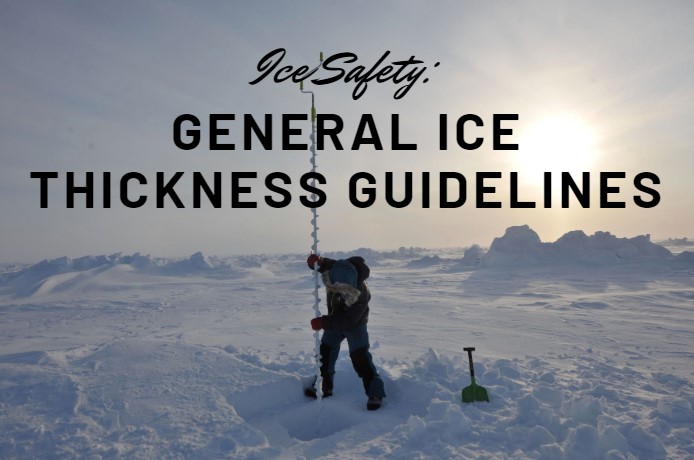
Can’t wait to lace up your skates? Before you head out onto your favorite lake or pond, be sure to brush up on these ice safety guidelines. Most importantly, remember the golden rule…NEVER go out alone! Original post by Minnesota DNR.

** For new, clear ice only **
UNDER 4″ – STAY OFF
4″ – Ice fishing or other activities on foot
5″ – 7″ – Snowmobile or ATV
8″ – 12″ – Car or small pickup
12″ – 15″ – Medium truck
Download Ice Thickness Guidelines PDF »
Many factors other than thickness can cause ice to be unsafe.
White ice or “snow ice” is only about half as strong as new clear ice. Double the above thickness guidelines when traveling on white ice.
Checking ice thickness
Before heading out on ice:
The DNR does not measure ice thickness on Minnesota lakes. Your safety is your responsibility. Check ice thickness at least every 150 feet.
Temperature, snow cover, currents, springs and rough fish all affect the relative safety of ice. Ice is seldom the same thickness over a single body of water; it can be two feet thick in one place and one inch thick a few yards away. Check the ice at least every 150 feet.
Ways to check ice thickness:

Ice chisel
An ice chisel is a metal rod with a sharp, flat blade welded onto one end. Drive the chisel into the ice, using a stabbing motion, to create a hole. Next, measure ice thickness with a tape measure.

Ice auger
There are 3 different kinds of augers: hand, electric and gas. Hand augers are low cost, light weight and quiet. Electric augers are also quiet, but use less manual labor than a hand auger. Gas augers drill through ice the fastest, but are heavier, noisier and generally more costly than hand or electric models. After drilling a hole with the ice auger, measure ice thickness with a tape measure.

Cordless drill
Using a cordless drill and a long, five-eighths inch wood auger bit, you can drill through eight inches of ice in less than 30 seconds. Most cordless drills that are at least 7.2 volts will work, but the type of bit is critical. You need a wood auger bit since they have a spiral called a “flute” around the shaft that metal drilling bits don’t. The flutes pull the ice chips out of the hole and help keep it from getting stuck, much in the way a full-sized ice auger works. After drilling a hole, measure ice thickness with a measure tape. Dry the bit and give it a quick spray of silicone lubricant after each use to prevent rust.

Tape measure
Use a tape measure to find ice’s true thickness. Put the tape measure into the hole and hook the bottom edge of ice before taking measurement. You can also use an ice fisherman’s ice skimmer with inch markings on the handle in place of the tape measure.
Don’t judge ice thickness by how easily a chisel or drill breaks the surface. It happens so quickly that it’s easy to overestimate the thickness.

Additional recommendations
Cars, pickups or SUVs should be parked at least 50 feet apart and moved every two hours to prevent sinking.
Tip: Make a hole next to the car. If water starts to overflow the top of the hole – the ice is sinking and it’s time to move the vehicle.
Re-posted by Scott Freerksen “The Lake Guy”
